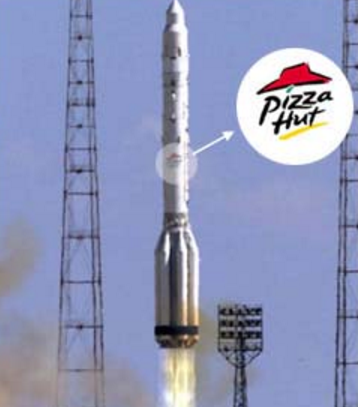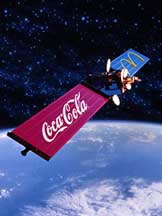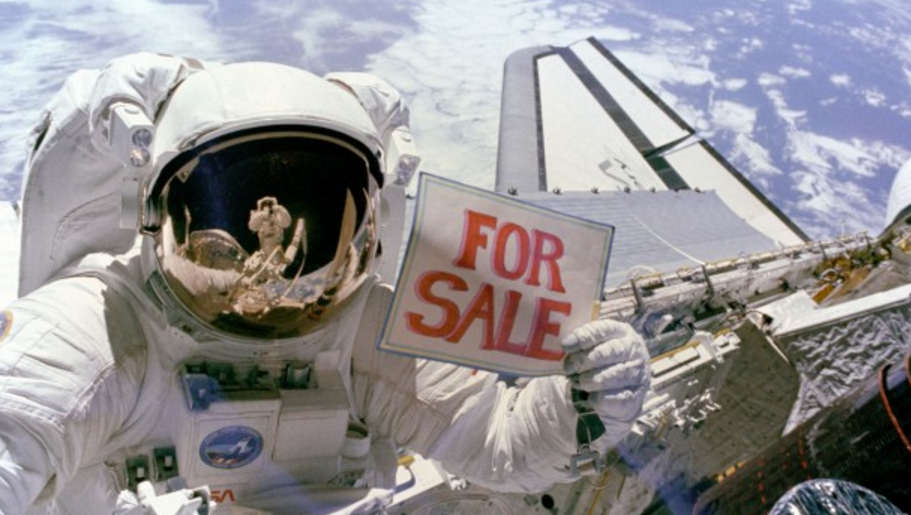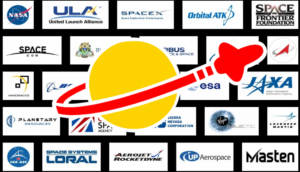Contents
- Space advertising projects
- 1. Tokyo Broadcasting System paid spaceflight for a journalist
- 2. The Space Billboard project by Space Marketing Inc
- 3. Filming of a milk commercial in space by the Israeli company Tnuva
- 4. Pizza Hut Space advertising
- 5. Pepsi space publicity stunt
- 6. The Russian Znamaya Project
- 7. The French Ring of Light project
- Why space advertising will not be realised anytime soon
- What is the solution for companies with a desire to advertise in space?
- Conclusion
This huge competition has led to the introduction of new and more creative methods of advertising, which has forced advertisers to consider unique advertising techniques such as advertising in the final frontier – outer space.
Unlike space industry advertising, the advertising of products and services unrelated to spaceflight in orbit has not yet become very common marketing technique. However, to date, it has been used by a number of organizations around the world, some with great success and others not so much.
Below is my look at the progress of space advertising alongside some of the most notable projects on record.
Space advertising projects
1. Tokyo Broadcasting System paid spaceflight for a journalist
One of the most notable space adverting project was the paid spaceflight by the Tokyo Broadcasting System in 1990, which sent the journalist Toyohiro Akiyama into space. The media company paid $10 million to the Russian space agency, a deal which also saw the company’s logo displayed on the launch vehicle. This was a very powerful publicity stunt by the media company, as Akiyama became the first journalist and one of the first non-astronaut personnel to go into orbit, thus earning the company a huge storm of publicity.
2. The Space Billboard project by Space Marketing Inc
One of the most famous space advertising campaign around the world was “The Space Billboard” concept of the American advertising company, Space Marketing Inc. The proposal, which would have been a turning point for space advertising, proposed the launch of a 1 square kilometre illuminated billboard into the low earth orbit where ads would be placed by various interested companies.
The proposed project led to a lot of controversy around the world, as it was believed that once launched into orbit, the reflective billboard would have been almost similar in size and brightness as the moon, and would have been visible from Earth (about 150 miles away) with the naked eye. In the end, the project was not realised as the company failed to come up with enough money to fully fund the development and launching of the billboard.
3. Filming of a milk commercial in space by the Israeli company Tnuva
Another famous publicity stunt was the filming of a milk commercial in space for the Israeli company Tnuva in 1997. The commercial, which became the first ad filmed in space was done aboard the Russian Mir space station.
When it was aired on an Israeli TV channel, the commercial gained a lot of publicity, especially given the strange connection between the Russian space station and the Israeli milk. The commercial, which was filmed by the Gitam/BBDO advertising agency was planned for 9 months and it cost the company about $450,000 for just a 95-seconds video. Watch it below.
4. Pizza Hut Space advertising
Pizza Hut is another company that has been largely involved in the race to monetize advertising in space. In 2000, the company paid approximately $1 million for a space ad that saw their new logo painted on a Proton rocket that was launched into the International Space Station by the Russia.
The launch of the rocket was viewed by approximately 500 million people around the world, thus earning the company a lot of publicity.
A year later, Pizza Hut also made another major stride in the space race, when it became the first company to deliver pizza into space. The delivery of the 6-inch salami pizza (the first pizza to be eaten in space) was a culmination of about 1 year of planning and several months of rigorous testing to make sure that the delivered pizza met the required space food standards! And for Pizza Hut, that really could have been a show-stopper.
Marketing experts, space fans all over the world and the general public viewed this as a major turning point for the commercialisation of space that could see other companies take similar actions, especially if the long-held vision of space tourism is realised. However, marketers have since discovered much more savvy ways to ensure product placement beyond our atmosphere, as we shall see below.
5. Pepsi space publicity stunt
 Pizza Hut is not the only company from America to pay the Russian space program a huge sum of money for a space publicity stunt.
Pizza Hut is not the only company from America to pay the Russian space program a huge sum of money for a space publicity stunt.
In 1996, Pepsi paid approximately $5 million to have a cosmonaut float a replica of the company’s soda can outside the Russian Mir space station.
Although it ain’t the real thing, Pepsi sure have a way of getting their product and message to the populace of capitalist nations, again, thanks to the Russians.
#Pepsi get their message across to capitalist nations from space, thanks to the Russians. #roscosmos Click To Tweet6. The Russian Znamaya Project
The Russian space program was yet again at the centre of space advertising with the proposed Znamaya project that involved the launch of satellites designed to reflect and beam sunlight to polar regions on Earth.
While the project was not presented as an advertising campaign, many people around the world felt that it would have served to advertise the Russian space agency and the system itself, especially given the fact that the first project, the Znamaya 2, illuminated parts of Europe and the second project (Znamaya 2.5) would have illuminated even regions in the US. Thankfully the project was abandoned after the failed launch of the Znamaya 2.5.
7. The French Ring of Light project
France is another country that attempted a space project that was viewed by a lot of people around the world as to being a tasteless advertising stunt. The project was “The Ring of Light”, which involved the launch of an inflatable ring in space dotted with a hundred reflective Mylar balloons, to celebrate the 100th anniversary of the Eiffel Tower. According to the designers of the project, the ring would be 15 miles in circumference and would be visible from earth, a distance of about 500 miles, in a similar size and brightness as the moon. The project was finally abandoned after it received widespread criticism from the international community.
Why space advertising will not be realised anytime soon
While these space advertising stunts show the huge strides that have been made in the exploitation of space, it is quite clear from the several failed or abandoned projects that widespread space advertising will not be realised anytime soon. This is because of several challenges, which include:
1. Criticism of obtrusive advertising
 The negative reaction that a lot of people around the world have to obtrusive space advertising (advertising in space that is capable of being seen on Earth with the naked eye) is one of the biggest challenges facing advertising in space. Unlike most ads, for example, TV commercials, online ads, and print ads, space advertising projects such as the launch of reflective billboards on satellites cannot be “turned off”and thus a lot of people feel like they are being forced to view the ads even when they are not the intended targets.
The negative reaction that a lot of people around the world have to obtrusive space advertising (advertising in space that is capable of being seen on Earth with the naked eye) is one of the biggest challenges facing advertising in space. Unlike most ads, for example, TV commercials, online ads, and print ads, space advertising projects such as the launch of reflective billboards on satellites cannot be “turned off”and thus a lot of people feel like they are being forced to view the ads even when they are not the intended targets.
This has led to a huge outcry whenever such projects are proposed, something that saw the banning of space advertising by the US after the proposed “Space Billboard” project by Space Marketing Inc. While the law was later amended later to only ban obtrusive advertising, space advertising in the US is still largely restricted.
Various organisations that are opposed to space advertising have also been increasingly campaigning for international cooperation in coming up with various measures to limit obtrusive space advertising. Therefore, even if space advertising is realised anytime soon, there is a high chance that the practice will be heavily restricted all over the world.
2. Negative impacts on astronomical observation
Another challenge facing space advertising is the negative impacts on astronomy due to human activity in space. advertising products in spacehas been criticised by many experts for the adverse effects it has on astronomy, which include light pollution, due to the use of artificial light sources in space such as reflective satellites and other substances (reflective balloons in the proposed Ring of Light project).
In addition to light pollution, space advertising also hampers peaceful astronomical study by obstructing the skies, creating radio interference and increasing space debris that can obstruct astronomical observation or risk collision with space vehicles on astronomical missions.
All these negative impacts on astronomy, which could also have adverse effects on the environment, have seen many astronomical experts, environmental activists, and space fans around the world to campaign against obtrusive space advertising, which has further added to the growing negative reception of the trend.
3. Expensive cost of advertising
Another major challenge facing organisations that wish to advertise in space is the costs involved. As we have already seen from some of the publicity stunts, the companies had to pay huge sums of money to space agencies that agreed to advertise their brand while some advertising projects failed because of lack of funds.
The huge cost of advertising means that several businesses will not be able to afford publicity in space and they will have to rely on other methods of advertising until it becomes more affordable – something that is not likely to happen anytime soon.
What is the solution for companies with a desire to advertise in space?
 Despite the widespread criticism of obtrusive space advertising and the huge costs that are involved, businesses with a desire to advertise in low earth orbit have several options they can result to, which will give them the publicity they need without causing any harm to astronomy or offence to the public.
Despite the widespread criticism of obtrusive space advertising and the huge costs that are involved, businesses with a desire to advertise in low earth orbit have several options they can result to, which will give them the publicity they need without causing any harm to astronomy or offence to the public.
These stunts are also pretty much unrestricted, and some of them are very affordable. Therefore, several businesses around the world are able to engage in them. Below is a look at some of the space advertising options that are currently available.
1. Advertising on rockets
One of the most popular space advertising stunts is paying space agencies that are launching rockets in space to add a logo on the rockets, which will then be visible to millions of viewers around the world during the launch. Several companies have used this method of publicity, the most famous of them being Pizza Hut. Other companies that have used this advertising stunt include the Tokyo Broadcasting System, Sony, Otsuka Pharmaceutical and Unicharm – during the launch of Soyuz TM-11 to the Russian space station in 1990.
2. Advertising through consumer products sent into space
Another way companies are able to advertise in space is by placing logos on consumer products that are sent into space for the crew. Pizza Hut and the Israeli company Tnuva have already leveraged this idea, as mentioned above. Other companies can also follow suit by delivering their own items into space or paying space publicity service providers to have their logos placed on items used in space. These branded items will then be viewed by millions of consumers around the world, giving the companies huge publicity.
3. Launching payloads into the ISS with a company’s logo
Another way businesses are able to advertise in the space is to launch their own CubeSat or small payloads into the International Space Station with logos on the payload. The launch can then be filmed focusing on the branded payload, and the video distributed all over the world through platforms such as YouTube to increase publicity.
Payload launch providers and others offer such services, with the most notable of them all being NanoRacks, which is famous for offering services such as payload launch and integration to help with the commercial utilisation of space.
Conclusion
 The marketing industry has found its way into the “space race”, as several businesses and organisations around the world rush to establish a huge reputation for themselves by paying top dollar to advertise in space. Unfortunately for businesses that would like all of this publicity, the trend has been met with a number of challenges that range from restriction of space advertising, growing criticism of space publicity stunts that are considered to be obtrusive, high cost of advertising in space, and the huge amount of time taken to plan and implement an advertising project in low earth orbit, or beyond.
The marketing industry has found its way into the “space race”, as several businesses and organisations around the world rush to establish a huge reputation for themselves by paying top dollar to advertise in space. Unfortunately for businesses that would like all of this publicity, the trend has been met with a number of challenges that range from restriction of space advertising, growing criticism of space publicity stunts that are considered to be obtrusive, high cost of advertising in space, and the huge amount of time taken to plan and implement an advertising project in low earth orbit, or beyond.
These challenges have served to derail the free and unlimited advertising in space, which does not seem like it will happen on a large scale any time soon. However, businesses around the world can still leverage the huge publicity attached to space exploration and colonization through methods such as paying for product placement, logo advertising on launch vehicles, rockets and satellites, branding items sent to the International Space Station, or sending branded payloads into orbit. When the current restrictions are likely to be revised or removed, we are yet to see.







![Yikes! Apparently people have been making Uranus jokes at least since this 1881 edition of the satirical magazine Puck.
[Found by Elizafox System on Mastodon]](https://pbs.twimg.com/media/FwWGy-DWAA4v1SQ.jpg)
